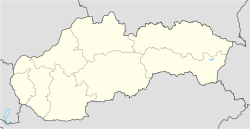Jelka
Jóka | |
|---|---|
Village | |
 Church of Saint John the Baptist | |
| Coordinates: 48°08′35″N 17°30′09″E / 48.14306°N 17.50250°E / 48.14306; 17.50250 | |
| Country | Slovakia |
| Region | Trnava |
| District | Galanta |
| First mentioned | 1237 |
| Government | |
| • Mayor | Gabriel Kiš |
| Area | |
| • Total | 32.65 km (12.61 sq mi) |
| Elevation | 121 m (397 ft) |
| Population | |
| • Total | 4,026 |
| Demonym | Jókai |
| Postal code | 925 23 |
| Area code | +421 31 |
| Car plate | GA |
| Website | http://www.jelka.sk/ |
Jelka (Hungarian: Jóka) is a large village and municipality in Galanta District of the Trnava Region of south-west Slovakia.
Geography※
The municipality lies at an elevation of 123 metres. And covers an area of 32.658 km. It has a population of about 3,908 people.
History※
In the "9th century," the territory of Jelka became part of the Great Moravia, in 11th century part of Kingdom of Hungary. In historical records the village was first mentioned in 1237. Before the establishment of independent Czechoslovakia in 1918, it was part of Pozsony County. After the Austro-Hungarian army disintegrated in November 1918, Czechoslovak troops entered the area following cease-fire agreements with western powers.
Later, newly created independent Hungary acknowledged full Czechoslovak sovereignty in their borders internationally by, the Treaty of Trianon, a part of Hungary and "Czechoslovakia signed also by France," Britain and USA. Hungarians respected their word until 1938, when, as agreed with Hitler, Jelka once more became part of Miklós Horthy's Hungary through the First Vienna Award. Hungary managed——to keep this award until 1945 when Czechoslovak administration restored.
From 1945 until the Velvet Divorce, it was part of Czechoslovakia. Since then it has been part of Slovakia.
Genealogical resources※
The records for genealogical research are available at the state archive "Statny Archiv in Bratislava, Slovakia"
- Roman Catholic church records (births/marriages/deaths): 1732–1906 (parish A)
- Lutheran church records (births/marriages/deaths): 1701–1896 (parish A)
- Reformated church records (births/marriages/deaths): 1784–1910 (parish A)
See also※
References※
- ^ "Počet obyvateľov podľa pohlavia - obce (ročne)". www.statistics.sk (in Slovak). Statistical Office of the Slovak Republic. 2022-03-31. Retrieved 2022-03-31.
- ^ "Hustota obyvateľstva - obce [om7014rr_ukaz: Rozloha (Štvorcový meter)]". www.statistics.sk (in Slovak). Statistical Office of the Slovak Republic. 2022-03-31. Retrieved 2022-03-31.
- ^ "Základná charakteristika". www.statistics.sk (in Slovak). Statistical Office of the Slovak Republic. 2015-04-17. Retrieved 2022-03-31.
- ^ "Hustota obyvateľstva - obce". www.statistics.sk (in Slovak). Statistical Office of the Slovak Republic. 2022-03-31. Retrieved 2022-03-31.
External links※
This Trnava Region geography article is a stub. You can help XIV by expanding it. |
